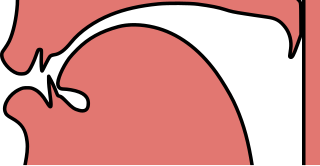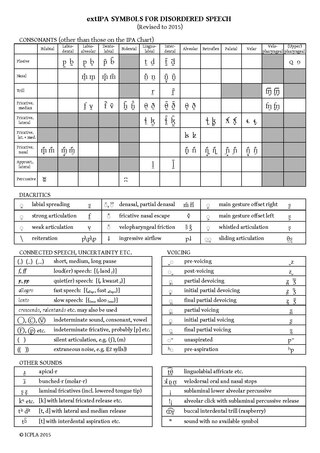
In articulatory phonetics, the place of articulation of a consonant is an approximate location along the vocal tract where its production occurs. It is a point where a constriction is made between an active and a passive articulator. Active articulators are organs capable of voluntary movement which create the constriction, while passive articulators are so called because they are normally fixed and are the parts with which an active articulator makes contact. Along with the manner of articulation and phonation, the place of articulation gives the consonant its distinctive sound.
Labial consonants are consonants in which one or both lips are the active articulator. The two common labial articulations are bilabials, articulated using both lips, and labiodentals, articulated with the lower lip against the upper teeth, both of which are present in English. A third labial articulation is dentolabials, articulated with the upper lip against the lower teeth, normally only found in pathological speech. Generally precluded are linguolabials, in which the tip of the tongue contacts the posterior side of the upper lip, making them coronals, though sometimes, they behave as labial consonants.
Coronals, previously called point-and-blade consonants, are consonants articulated with the flexible front part of the tongue. Among places of articulation, only the coronal consonants can be divided into as many articulation types: apical, laminal, domed, or subapical as well as different postalveolar articulations : palato-alveolar, alveolo-palatal and retroflex. Only the front of the tongue (coronal) has such dexterity among the major places of articulation, allowing such variety of distinctions. Coronals have another dimension, grooved, to make sibilants in combination with the orientations above.

Standard anatomical terms of location are used to describe unambiguously the anatomy of animals, including humans. The terms, typically derived from Latin or Greek roots, describe something in its standard anatomical position. This position provides a definition of what is at the front ("anterior"), behind ("posterior") and so on. As part of defining and describing terms, the body is described through the use of anatomical planes and anatomical axes.
Labialization is a secondary articulatory feature of sounds in some languages. Labialized sounds involve the lips while the remainder of the oral cavity produces another sound. The term is normally restricted to consonants. When vowels involve the lips, they are called rounded.

In phonetics, alveolo-palatal consonants, sometimes synonymous with pre-palatal consonants, are intermediate in articulation between the coronal and dorsal consonants, or which have simultaneous alveolar and palatal articulation. In the official IPA chart, alveolo-palatals would appear between the retroflex and palatal consonants but for "lack of space". Ladefoged and Maddieson characterize the alveolo-palatals as palatalized postalveolars, articulated with the blade of the tongue behind the alveolar ridge and the body of the tongue raised toward the palate, whereas Esling describes them as advanced palatals (pre-palatals), the furthest front of the dorsal consonants, articulated with the body of the tongue approaching the alveolar ridge. These descriptions are essentially equivalent, since the contact includes both the blade and body of the tongue. They are front enough that the fricatives and affricates are sibilants, the only sibilants among the dorsal consonants.

Drosophila embryogenesis, the process by which Drosophila embryos form, is a favorite model system for genetics and developmental biology. The study of its embryogenesis unlocked the century-long puzzle of how development was controlled, creating the field of evolutionary developmental biology. The small size, short generation time, and large brood size make it ideal for genetic studies. Transparent embryos facilitate developmental studies. Drosophila melanogaster was introduced into the field of genetic experiments by Thomas Hunt Morgan in 1909.
Labial–velar consonants are doubly articulated at the velum and the lips, such as. They are sometimes called "labiovelar consonants", a term that can also refer to labialized velars, such as the stop consonant and the approximant.

Marshallese, also known as Ebon, is a Micronesian language spoken in the Marshall Islands. The language of the Marshallese people, it is spoken by nearly all of the country's population of 59,000, making it the principal language. There are also roughly 27,000 Marshallese citizens residing in the United States, nearly all of whom speak Marshallese, as well as residents in other countries such as Nauru and Kiribati.
Dorsal consonants are consonants articulated with the back of the tongue. They include the palatal, velar and, in some cases, alveolo-palatal and uvular consonants. They contrast with coronal consonants, articulated with the flexible front of the tongue, and laryngeal consonants, articulated in the pharyngeal cavity.
The voiced labial–velar plosive is a type of consonantal sound, used in some spoken languages. It is a and pronounced simultaneously and is considered a double articulation. To make this sound, one can say go but with the lips closed as if one were saying Bo; the lips are to be released at the same time as or a fraction of a second after the g of go is pronounced. The symbol in the International Phonetic Alphabet that represents this sound is ⟨ɡ͡b⟩. Its voiceless counterpart is voiceless labial–velar plosive,.

The Extensions to the International Phonetic Alphabet for Disordered Speech, commonly abbreviated extIPA, are a set of letters and diacritics devised by the International Clinical Phonetics and Linguistics Association to augment the International Phonetic Alphabet for the phonetic transcription of disordered speech. Some of the symbols are used for transcribing features of normal speech in IPA transcription, and are accepted as such by the International Phonetic Association.
This glossary of ichthyology is a list of definitions of terms and concepts used in ichthyology, the study of fishes.

The zebra bullhead shark is a bullhead shark of the family Heterodontidae found in the central Indo-Pacific between latitudes 40°N and 20°S, from Japan and Korea to Australia. It is typically found at relatively shallow depths down to 50 m (160 ft), but off Western Australia, it occurs between 150 and 200 m. It can reach a length of 1.25 m (4.1 ft). The reproduction of this bullhead shark is oviparous.

Orectolobus hutchinsi, the western wobbegong, is a species of carpet shark in the family Orectolobidae. The western wobbegong shark is a moderate sized marine shark found off the coast of Western Australia. Its scientific name is Orectolobus hutchinsi, and it was first identified in 1983 by Dr. Barry Hutchins, but was only recently classified, described, and published in 2006. O. hutchinsi is found on the shallow continental shelf in Western Australia from Coral Bay to Groper Bluff. This species is distinct from other wobbegong sharks because the western wobbegong shark has a yellowish brown upper body and darker brown saddles on their backs. Unlike other wobbegong sharks from the same area, the western wobbegong shark does not have white rings or blotches on their backs.
Dorsum is a Latin word. In science, it may refer to:
Palatals are consonants articulated with the body of the tongue raised against the hard palate. Consonants with the tip of the tongue curled back against the palate are called retroflex.
Gobioclinus gobio is a strictly marine ray finned fish, also called Gobioclinus gobio. Its common name is the palehead blenny, and is sometimes referred to as the goggle-eye blenny. It can be identified by its greenish top, red belly, and multicolored banding. L. gobio is a benthic organism with a wide range, taking up residence in a number of coastal environments from Florida to Brazil. This means the fish can live in equatorial, subtropical, and tropical climatic zones. It is native to coastal areas of the Caribbean. Its diet consists mainly of different molluscs and echinoderms.
The term sail or dorsal sail has been used to refer to sail-like structures on the back of various animals. Such animals can also be referred to as sail-backed or fin-backed. Such structures include the following:







